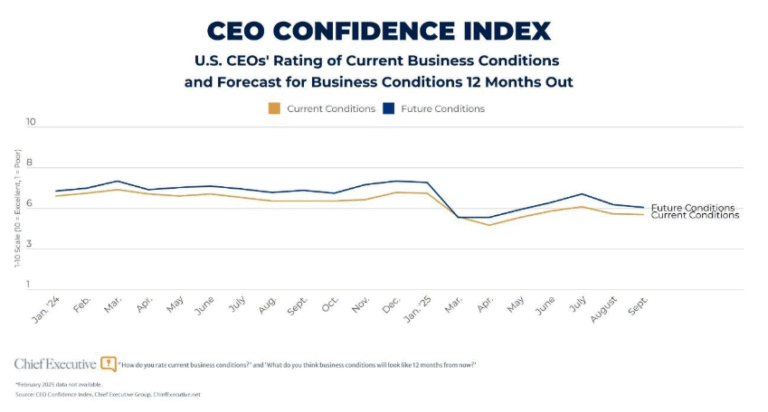
One certain side effect of an uncertain times is that many executives just can’t handle it.
As global markets brace for potential impact from some of the most uncertain political times in recent memory, C-Suite officers are struggling with how to stay on strategy. This year has brought enormous uncertainty around everything from trade policy to interest rates to energy prices. The ensuing uncertainty cascades quickly into corporate headquarters. Indeed, one of the toughest things a CEO has to do today is stay focused and steady when the business comes under stress. Something like a fast change in trade or markets or stock price dip can send the company into overreaction mode —trying to fix things that aren’t even broken.
Uncertainty can cause even the strongest executives to react in negative ways, as they try to jump ahead of changes and second-guess strategy, usually with bad results. This “wartime” mentality — a feeling as if you’re operating under siege — is very different from leading during a time of steadier growth. One of the CEOs we work with shared a perspective expressed by many of his peers: “My very best peace-time advisor was my worst team member in a crisis.”
Observing business leaders working through these times of crisis, we have seen three common “panic behaviors” among executives that can derail a company. These emotional impulses not only are ineffective, but magnify problems and affect all members of the management team:
Panic Behavior #1: Focusing too much on “process”.
What it looks like: One of the most common stress responses is to get bogged down in small details, slowing things down so that they move at a bureaucratic pace. A good example is an executive who focuses on adherence to process above all else, such as reinforcing the travel policy thinking that this is helpful and additive to the quest for a good outcome.
Why it fails: Getting caught up in these less mission-critical process items deflates the team and misses the opportunity to think creatively about solutions. Getting penalized for these small “fouls” is demoralizing to everyone.
Panic Behavior #2: Being egocentric and deflecting blame.
What it looks like: Executives displaying this behavior during stressful times maneuver to ensure that one of their peers gets all of the scrutiny — effectively taking the heat off from themselves. They can become highly emotional and personalize every discussion.
Why it fails: This behavior causes a domino effect on the entire team, as it puts people on the defensive and looking backward instead of forward. The whole team becomes totally ineffective in its pursuit of developing plans that will lead it out of the mess.
Panic Behavior #3: Going into panic mode and wanting to change everything.
What it looks like: When a high-performing business starts to underperform, a natural reaction is to panic and begin to examine and change everything. With good intent and a desire to be part of the solution, there can be a flurry to “activate” — CEOs seeking to just *do* something.
Why it fails: Change is often what the business needs – but not always and not necessarily all things. The panic mode can cause executives to start to “fix” things that aren’t broken, creating problems where none existed and diffusing focus on the areas that do need reevaluation.
How a CEO can get the team back on track
Combating these derailers — which can happen even with the company’s highest performers — calls for CEOs to take decisive action to get the executive and the team back on course. These can include:
1. “Go slow to go fast.”The “go slow” component means to step back and diagnose before activating on those things that require intervention – and not everything requires intervention. Ruthless focus and prioritization is equally important in a stress event; you cannot be overcome by your organization’s quest to “do things.”
2. Be the absorber. A stress event or crisis requires the CEO as a leader to be calm, cool, and collected, and “absorb” the panic on the team. The CEO must be the focuser, redirecting the energy to help everyone focus on the problem, the facts, the supporting data, and the proposed solutions. The moment a CEO panics, there is a 100X amplification into the company and then people start to worry about the implications for them and are not focused on leading through the issues.
3. Give “permission” to be opportunistic.While reverting to process can give some executives a feeling of security — controlling what actually can be controlled — surviving a crisis requires companies to be opportunistic and to be even more creative in solving problems. This is a time that demands out-of-the-box thinking and jumping on opportunities that could lead the way out of a challenging period. CEOs may need to remind their team to think more expansively and to explicitly give them “permission” to take risks — there may be “rules” or siloes or business models that need to be broken in order to forge the path ahead.
Constant volatility makes the CEO job that much more demanding — requiring CEOs to adopt different leadership styles in real time. Leaders who can pivot quickly to identify those who don’t deal well with uncertainty and work to counteract their possibly damaging impact are putting themselves and their companies in a better position to withstand crises — self-made or not.
Read more: Investing In Millennials’ Soft Skills Could Benefit The Bottom Line



Chief Executive Group exists to improve the performance of U.S. CEOs, senior executives and public-company directors, helping you grow your companies, build your communities and strengthen society. Learn more at chiefexecutivegroup.com.
0

1:00 - 5:00 pm
Over 70% of Executives Surveyed Agree: Many Strategic Planning Efforts Lack Systematic Approach Tips for Enhancing Your Strategic Planning Process
Executives expressed frustration with their current strategic planning process. Issues include:
Steve Rutan and Denise Harrison have put together an afternoon workshop that will provide the tools you need to address these concerns. They have worked with hundreds of executives to develop a systematic approach that will enable your team to make better decisions during strategic planning. Steve and Denise will walk you through exercises for prioritizing your lists and steps that will reset and reinvigorate your process. This will be a hands-on workshop that will enable you to think about your business as you use the tools that are being presented. If you are ready for a Strategic Planning tune-up, select this workshop in your registration form. The additional fee of $695 will be added to your total.

2:00 - 5:00 pm
Female leaders face the same issues all leaders do, but they often face additional challenges too. In this peer session, we will facilitate a discussion of best practices and how to overcome common barriers to help women leaders be more effective within and outside their organizations.
Limited space available.

10:30 - 5:00 pm
General’s Retreat at Hermitage Golf Course
Sponsored by UBS
General’s Retreat, built in 1986 with architect Gary Roger Baird, has been voted the “Best Golf Course in Nashville” and is a “must play” when visiting the Nashville, Tennessee area. With the beautiful setting along the Cumberland River, golfers of all capabilities will thoroughly enjoy the golf, scenery and hospitality.
The golf outing fee includes transportation to and from the hotel, greens/cart fees, use of practice facilities, and boxed lunch. The bus will leave the hotel at 10:30 am for a noon shotgun start and return to the hotel after the cocktail reception following the completion of the round.